SN Dey Class 11 Solutions | SN Dey Class 11 Trigonometry Solutions | SN Dey Class 11 Trigonometric Ratios of Compound Angles Multiple Choice Type Questions | Trigonometric Ratios of Compound Angles MCQ | SN Dey Solutions | S N Dey Math Solutions | Trigonometric Ratios of Compound Angles S N Dey Solutions | WBCHSE Class 11 Math Solutions | Trigonometric Ratios of Compound Angles objective questions | SN Dey Trigonometry
SN Dey Class 11 Chapter Solutions. Compound Angles MCQ. Trigonometric Ratios MCQ
Choose the correct option:
Ex 1: sin(A+B) sin(A-B)
(A) sin2A – sin2B (B) cos2A – sin2B (C) cos2B – sin2B (D) cos2A – cos2B
Solution:
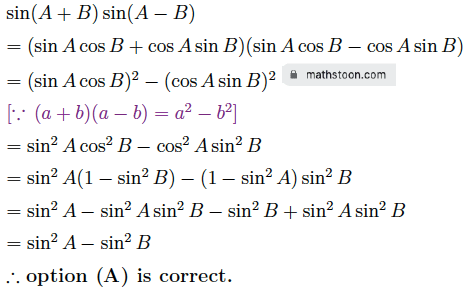
Ex 2: cos(A+B) cos(A-B)
(A) sin2A – sin2B (B) cos2A – sin2B (C) cos2B – sin2B (D) cos2A – cos2B
Solution:
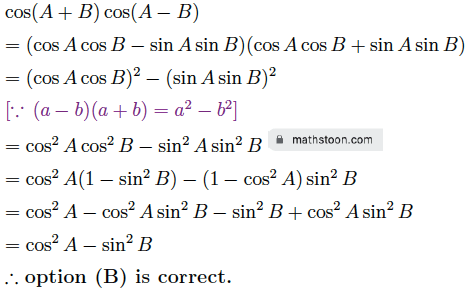
Ex 3: sin(45°-θ)
(A) $\dfrac{1}{\sqrt{3}}$(sinθ – cosθ) (B) $\dfrac{1}{\sqrt{2}}$(sinθ – cosθ) (C) $\dfrac{1}{\sqrt{3}}$(cosθ – sinθ) (D) $\dfrac{1}{\sqrt{2}}$(cosθ – sinθ)
Solution:
sin(45°-θ)
= sin45° cosθ – cos45° sinθ
= $\dfrac{1}{\sqrt{2}}$ cosθ – $\dfrac{1}{\sqrt{2}}$ sinθ
= $\dfrac{1}{\sqrt{2}}$ (cosθ – sinθ)
∴ Option (D) is correct.
Ex 4: tan(π/4+θ) tan(π/4-θ)
(A) 0 (B) $\dfrac{1}{\sqrt{3}}$ (C) 1 (D) $\sqrt{3}$
Solution:
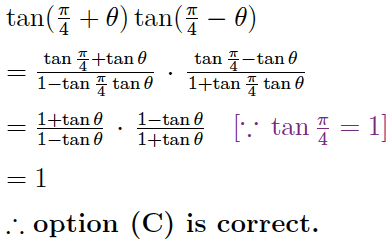
Also Read:
| SN Dey Class 11 Set Theory MCQ Solutions |
| SN Dey Class 11 Limits MCQ Solutions |
| SN Dey Class 11 Trigonometry Multiple Angles MCQ Solutions |
Ex 5: cot 2θ + tan θ =
(A) sin22θ (B) cot22θ (C) cosec22θ (D) tan22θ
Solution:
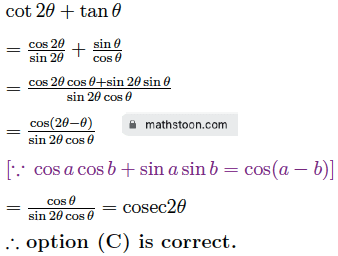
Ex 6: 2cos(π/3+A) =
(A) cosA – √3sinA (B) cosA – √2sinA (C) sinA – √3cosA (D) sinA – √2cosA
Solution:
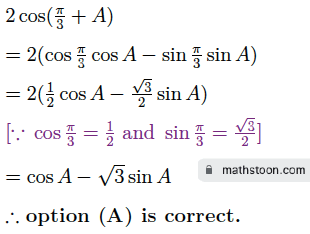
Ex 7: If sinA = $\dfrac{3}{5}$, cosB = $-\dfrac{12}{13}$, where A and B both lie in second quadrant, then the value of sin(A+B) is –
(A) $\dfrac{56}{65}$ (B) $-\dfrac{56}{65}$ (C) $\dfrac{65}{56}$ (D) $-\dfrac{65}{56}$
Solution:
As both A and B lie in second quadrant, the value of cosA and sinB are respectively negative and positive.
∴ cosA = $-\sqrt{1-\sin^2 A}$ $=-\sqrt{1-\dfrac{9}{25}}$ $=-\sqrt{\dfrac{16}{25}}$ $=-\dfrac{4}{5}$ and
sinB = $\sqrt{1-\cos^2 B}$ $=\sqrt{1-\dfrac{144}{169}}$ $=\sqrt{\dfrac{25}{169}}$ $=\dfrac{5}{13}$
Now, sin(A+B)
= sinA cosB + cosA sinB
= $\dfrac{3}{5} \cdot (-\dfrac{12}{13})$ + $(-\dfrac{4}{5}) \cdot \dfrac{5}{13}$
= $-\dfrac{36}{65}-\dfrac{20}{65}$
= $-\dfrac{36+20}{65}$
= $-\dfrac{56}{65}$
∴ Option (B) is correct.
Ex 8: $\dfrac{\cos 9^\circ +\sin 9^\circ}{\cos 9^\circ -\sin 9^\circ}$
(A) sin54° (B) cos54° (C) tan54° (D) cot54°
Solution:
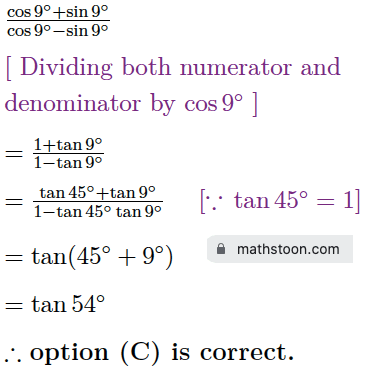
Ex 9: If sinA + sinB = 2, then which of the following is the value of sin(A+B)?
(A) 2 (B) 0 (C) 1 (D) -1
Solution:
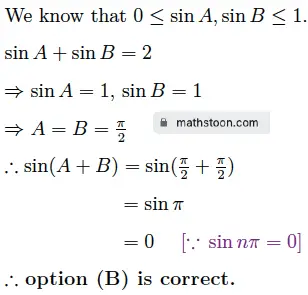
Ex 10: If sinθ + sinφ = 2, then which of the following is the value of cos(θ+φ)?
(A) 0 (B) 1 (C) -1 (D) 2
Solution:
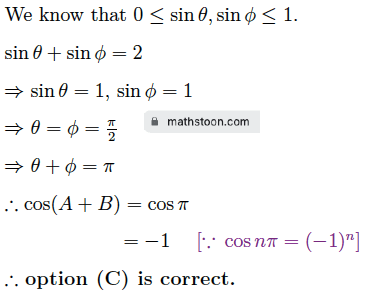
Ex 11: If cosA + cosB = 2, then which of the following is the value of cos(A+B)?
(A) 1 (B) 0 (C) -1 (D) 2
Solution:
As both cosA and cosB lie between 0 and 1, we have:
cosA + cosB = 2
⇒ cos A =1, cos B =1
⇒ A=0° and B=0°
⇒ A+B=0°
∴ cos(A+B) = cos 0° = 1.
∴ Option (A) is correct.
Ex 12: If tanA = $\dfrac{3}{4}$ and tanB = $\dfrac{4}{3}$, then which of the following is the value of (A+B)?
(A) $\dfrac{\pi}{4}$ (B) $\dfrac{3\pi}{4}$ (C) $\pi$ (D) $\dfrac{\pi}{2}$
Solution:
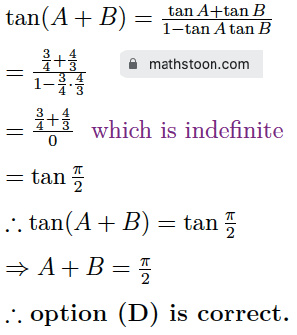
This article is written by Dr. T, an expert in Mathematics (PhD). On Mathstoon.com you will find Maths from very basic level to advanced level. Thanks for visiting.